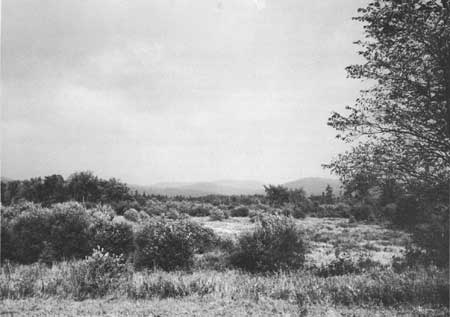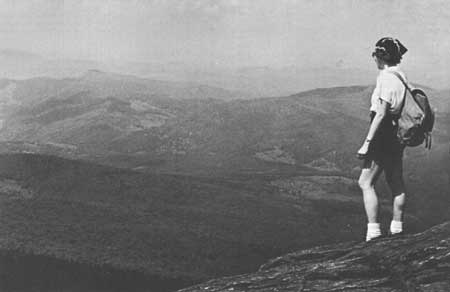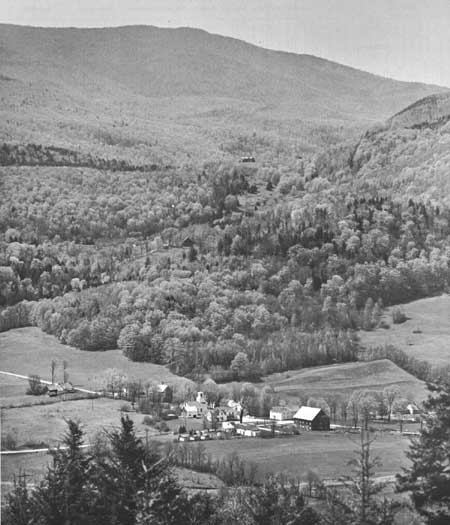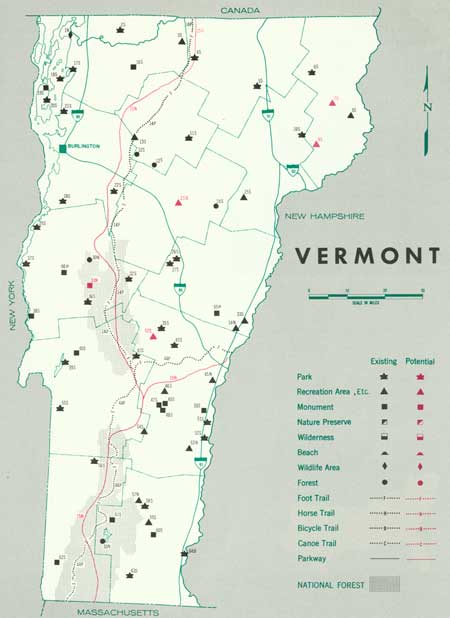.gif)
Parks for America
MENU
|
Parks for America
|

|

|
| In Essex County, Vt., lands near Victory, embracing an authorized reservoir project of the Corps of Engineers, have been recommended for a State recreation area. |
VERMONT
VERMONT offers a picturesque setting of mountains, lakes, and rivers for recreation, serving especially residents of southern New England and the New York metropolitan region.
Predominantly rural, the 1960 population of 389,881 is expected to decrease slightly, with 377,000 forecast for 1976. Only 38 percent is urban. The population density is 42 per square mile. The largest city in the State is Burlington, with 35,531 residents.
Tourism, the second-ranking industry in Vermont, accounted for about a $115 million income to the State in 1960, increasing from $55 million in 1946. Forestry, agriculture, manufacturing, mining, and general construction are the other major industries.
Ninety percent of the visitors come by automobile. Completion of the Interstate System will place Vermont within a day's driving distance of approximately a third of our Nation's growing population. Ease of automobile access is also rapidly increasing the recreation use of Lake Champlain by Canadians from Montreal, Canada's largest city, less than 1 hour's drive away.
The Green Mountains provide a scenic backdrop to 120-mile-long Lake Champlain to the west, and to the winding, forested slopes of the Connecticut Valley to the east. Vermont abounds with cold-water streams and numerous lakes and ponds. Hunting and fishing are excellent and attract many nonresidents. There are many significant historic sites associated with Vermont's struggle for independence from New York, the American Revolution, the State's economic and cultural development, and its sons who achieved national recognition. The recreation potential in Vermont is extensive, varied, and abundant, embracing scientific and scenic values.
The climate is ideal for year-round outdoor recreation. Summer days are comfortable and the evenings are normally cool. Snow for winter sports is dependable from late November through most of March.
EXISTING PUBLIC AREAS
NATIONAL: The Forest Service administers the Green Mountain National Forest of 231,825 acres. The forest has four recreation areas. The Bureau of Sport Fisheries and Wildlife has one national wildlife refuge of 3,700 acres. The Corps of Engineers administers four reservoir areas totaling 4,715 acres.
STATE: The Department of Forests and Parks administers 37 parks and related areas totaling 14,106 acres, with a 1960 attendance of 734,626, and 28 forests comprising 72,525 acres. The Board of Historic Sites has 11 sites. The Fish and Game Service administers 112 areas totaling 28,525 acres, including 84 fishing access sites. The State Highway Department provides 32 wayside rest areas.
QUASI-PUBLIC AND PRIVATE: Two historic monuments are open to the public. The Long Trail and Appalachian Trail together traverse much of the Green Mountain range.
PRIVATE ENTERPRISE: Large resort developments, hotels, motels, tourist homes, and numerous small housekeeping cabins and sporting camps provided facilities for an estimated 1.5 million visitors in 1960. Private camps and cabins are increasing on almost all accessible waters. Many of the ski areas are privately developed; some lifts are operated year round. There are several private scenic toll roads.

|
| Vermont's Green Mountains from Mt. Killington on the Appalachian Trail. The trail deserves protection along its 2,000-mile course through 13 States. (VONDELL, GREEN MOUNTAIN CLUB.) |
PARK AND RELATED NEEDS
Vermont needs additional public recreation lands. The 14,106 acres in State parks are inadequate to meet the demands of both State residents and the ever-increasing influx of out-of-State visitors. This in crease can only be partially absorbed by recreation use of other public lands. Areas that provide outstanding natural attractions should be protected through acquisition or other means.
Portions of the Lake Champlain shoreline and sites on the shores of the larger lakes should be acquired while still available. Certain streams should be retained in their free-flowing state.
In recognition of the importance of tourism to the State's economy, the Vermont Park Service is under taking a program to expand park acreages and facilities. Weekend visits from the more populous States of New York, Massachusetts, and Connecticut will increase the need for day and weekend facilities, especially in the southern part of the State.
The State has made excellent progress in marking some existing roads as scenic routes. A complete marked system of scenic routes could be developed.
One of Vermont's invaluable scenic and recreation attractions is the picturesque panorama of villages and farms against a setting of lakes, rivers, and mountains. The protection of this distinctive atmosphere is of recognized importance to the State. Such protection will require the closest cooperation and strengthening of State and local efforts at planning, purchase of easements, billboard controls, and zoning.
No locally administered nonurban recreation lands were inventoried during the course of this study. To accommodate the minimum requirements of the State's urban population would require the acquisition of an estimated 2,700 acres in this category.

|
| Mountain-set Plymouth, Vermont, birthplace of President Coolidge. State and local planning is needed to protect New England's quiet charm. (VERMONT DEVELOPMENT DEPARTMENT.) |
RECOMMENDATIONS
Existing recreation resources and potential areas are shown on the accompanying tabulation and map. If the following recommendations can be vigorously implemented, they may help to provide needed outdoor recreation opportunities for public enjoyment and use.
NATIONAL: Continued studies of a possible Robert Frost Historic Site.
Re-evaluation of the desirability and feasibility of the Green Mountain Parkway suggestion as part of an Appalachian Parkway system.
STATE: Possible recreation area establishment around the Victory Reservoir project as part of Vermont's State park program.
In preserving Vermont's irreplaceable recreation resources, special emphasis should be placed on the acquisition of desirable shoreline along Lake Champlain. Indeed, protection of natural scenic shorelines on many of Vermont's best lakes and ponds is very important. Although Vermont law gives some rights for the Long Trail, easements are needed along other existing foot trails on private lands.
Supporting recommendations include—
1. Protection of the natural values found in free flowing streams within settings that are still undeveloped.
2. Exploratory studies of recreation opportunities during the planning and development of reservoir projects.
3. Continuation of State and local efforts to preserve a number of the significant historic sites.
(Table omitted from online edition)

|
| (click on image for an enlargement in a new window) |
NEXT >>>
|
|
Last Modified: Mon, Sep 6 2004 10:00:00 pm PDT
parks_america/vermont.htm
 Top
Top